The "Treasures of Egypt" Tour
This year, for the first time, we organised a tour just of Egypt, and because we were there longer than normal, the 15 members of the group visited many places we usually omit.
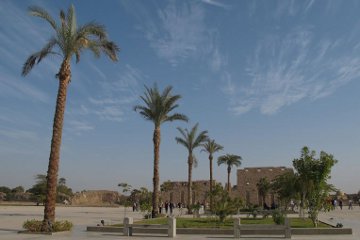
| |
| A splendid new plaza recreates something of the atmosphere as pilgrims approached Karnak temple, the largest religious structure in the world. |
The first day was taken up with viewing the reconstruction of Tutankhamun's tomb as it was in 1922 in the Pharaonic Village, and then in the afternoon seeing the real treasures in the Cairo Museum. The next day we took an early morning flight to Luxor where our guide, Amal, showed the group around the Temples of Karnak and Luxor. Because it was early in the season, both temples were empty of tourists and we wandered among the massive pylons, gigantic columns and hieroglyphic reliefs unhurried by crowds. Many of the group claimed that the temples were the most dramatic sites we visited.
A feature of the tour was the time allocated for shopping. Our hotel in Luxor is only a short walking distance from two bazaars and tour members returned to the hotel with armfuls of purchases that they proudly displayed to the others. The pattern was to be repeated in several other locations! While in Luxor, we arranged to meet the grandson of the chief workman who assisted Howard Carter excavate the tomb of Tutankhamun in 1922. He joined us in the hotel and briefly told us of his grandfather, showing us old photographs of the discovery. Like generations of his ancestors, the grandson still lives in the village of Qurna, built over the top of many ancient tombs.
During the free day in Luxor, some of our group visited the famous tomb of Nefertari in the Valley of the Queens. Until recently, access was so restricted that bookings had to be made months in advance, but now tickets are available to the first 150 people who queue at the ticket office from 6am each day. The members of our group were so keen that they left the hotel before sunrise to be first in the queue and then were granted twice the normal time to admire the recently restored paintings in the tomb of the famous queen of Rameses II.

| |
| The village of Deir al-Medineh housed the workmen who excavated the tombs in the Valley of the Kings |
Usually we spend only one day on the West Bank of the Nile exploring the funerary temples and tombs, but this year we had two days and so visited more places than usual. Our first day began at the two statues of Amenhotep III, known as the "Colossi of Memnon", before we travelled up into the desert hills to explore the village of Deir el-Medina. This was where the workmen who cut the royal tombs in the Valley of the Kings lived during the 18th and 19th dynasties. Excavations have uncovered extraordinary details of the individuals who lived here - stonemasons, painters, sculptors, quarrymen and scribes - and revealed not only their names but also the details of their personal lives, including their wives and children. They created some of the greatest works of art in the royal tombs, as well as cutting tombs for themselves and their families, all painted with the same skill. They built their houses in the valley, erected temples to their own gods, wrote prayers and business records on papyrus and pieces of stone and left a unique record of their daily lives. We visited two of the tombs in the nearby hill overlooking the town, including the famous tomb of Sennedjem.
The "Tombs of the Nobles" at Qurna includes the large tomb of Ramose where a series of exquisite paintings shows his funeral, even down to the professional mourners hired to weep. This tomb is unique since its construction spanned the years both before and after the introduction of monotheism under Akhnaton. Some reliefs show Akhnaton standing beneath the beneficent rays of the Aten, the one God. But the tomb reliefs were never finished and part of the wall shows only the sketched outlines of some scenes.
The day was topped off with a visit to the Ramesseum, the huge funerary temple built by Rameses II in which stood a 17.5 metre high statue of himself. Now broken in pieces and lying on the ground, the polished granite of the torso is inscribed with Rameses' royal cartouche. We wandered through the remains of a vast hypostyle hall and gazed up at the reliefs of Rameses. The following day, we visited the temple of Hatshepsut at Deir el-Bahri, the temple of Rameses III at Medinet Habu and the tombs in the Valley of the Kings. This year we explored the tombs of Rameses IX, Rameses III and Merneptah before entering the tomb of Tutankhamen to gaze in awe at the golden coffin still containing his mummy.
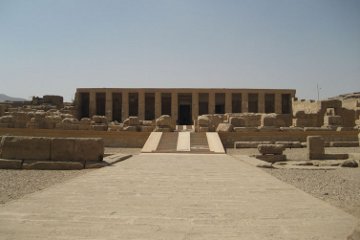
| |
| The temple of Seti I at Abydos contains an important king-list. |
A feature of this year's tour was the day trip from Luxor to Abydos, the site of the temple of Seti I. The walls are covered with reliefs, many in excellent condition. The famous "king list" shows Seti with a censer, and the crown prince, later Rameses II, wearing the side-lock of youth and reciting hymns from a papyrus roll. They are revering their 76 royal ancestors whose names are listed, each in an oval cartouche. The list begins with the first king of Egypt, Menes and continues down to Seti. The names of unimportant or illegitimate rules (like Akhenaton and Tutankhamen) are omitted.
The next day our tour included two more temples not usually on our itinerary. We travelled by road south from Luxor to Aswan, stopping for an hour at the Ptolemaic temple of Edfu, which has a huge statue of Horus in the first courtyard, and the temple of Kom Ombo, a centre of the worship of the crocodile god Sobek. A small museum next to the temple houses several mummified crocodiles found in the temple.
After our arrival at the New Cataract Hotel in Aswan, some of our group joined me for a boat ride to the region near the First Cataract. At Sahel Island we hiked up to see the famous inscription known as "Hungry Rock". The hieroglyphic inscription records seven years when the Nile River did not flood high enough to fertilise and irrigate the fields. Such an event, rare in ancient Egypt, meant disaster and famine as a result. Some have equated the famine mentioned in this inscription with the one reported in the Bible as occurring in the time of Joseph (Genesis 41-47).
During our morning tour of Abu Simbel the next day, I was impressed by the extensive tourist facilities recently constructed at the entrance. The new complex includes a visitor centre with audio-visual presentations, maps, diagrams, pictures and an account of the salvage work in rescuing the temple from the rising waters behind the Aswan Dam. A modern ticket office, clean toilets and a huge new covered bazaar area greet the visitor. Under the shade of trellis and vines, there are seats for visitors and green grass and flowering trees surround the whole area.
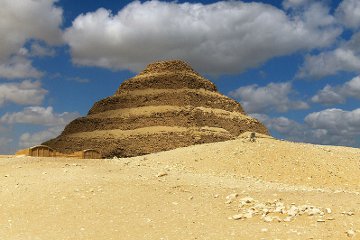
| |
| The Step Pyramid of Djoser at Saqqara, the first monumental building in stone. |
Our tour on the final Sunday included a trip to the village of Mit Rahina, the site of ancient Memphis, and the nearby necropolis of Saqqara to see the Step Pyramid of Zoser. Although visitors cannot go into the Step Pyramid, we were able to go inside the mastabas of Mereruka and Ka-Omni and the Sixth Dynasty pyramid of Teti.
From Saqqara we hurried back to Giza. The current policy for visiting the pyramid of Khufu is that 150 tickets only are available at 8am and 1pm each day. Those of our group who wished to go inside stood in the blazing sun for half an hour until the ticket office opened. They soon entered the pyramid that has been the focus of world-wide attention - National Geographic magazine has been sponsoring the exploration of one of the "air shafts" in the Queen's Chamber using a robot with a remote controlled video camera attached. The Queen's Chamber was not open this year, probably because research is still going on, but the galleries leading up to the King's Chamber were open.
The Great Pyramid is surrounded by hordes of vendors intent on selling you everything from fake scarabs to cheap papyrus. The whole experience always gives visitors a new insight into the term "pyramid selling". Even the inside galleries were full of people - many more than the 150 officially allowed in - so that the pyramid interior was both hot and claustrophobic for some in the group. By contrast, our group found the tour to Meidum and Dahshur a couple of days later much more satisfying. Here are three pyramids built by Sneferu, father of Khufu, and the whole day saw the complete absence of anyone but ourselves. We entered both the collapsed pyramid of Meidum, and the Red Pyramid with its maze of shafts leading to the three chambers. The lack of crowds meant that there was quietness and plenty of room to enjoy the experience.
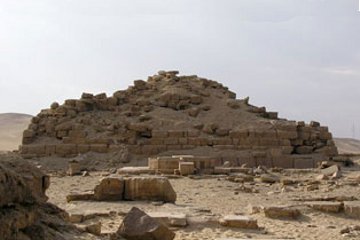
| |
| The ruins of the Sun Temple at Abu Ghurab. |
During the return journey to Cairo, we visited the Fifth Dynasty sun temple of Abu Ghurab near Abusir. This was a "first time" experience, not only for the group but also for us, since access to the temple is difficult and not often attempted. Certainly no tourist groups go there. The temple consisted of a courtyard 100 metres long by 75 metres wide surrounded by a brick wall with an entrance at the eastern end. At the west end of the enclosure was a large obelisk of the sun that stood 70 metres high, although only the lower part of the platform remains to be seen now. The obelisk represented the first resting place of the rising sun. In front of the obelisk was an altar, 5.5 metres across, made of massive alabaster blocks. Animals were sacrificed and channels in the paving carried the blood into ten alabaster basins, nine of which have been preserved. The cult of sun worship reached its height during the Fifth Dynasty when it was declared the state religion, and the kings took the title of "son of Re" (the sun god).
For the first time, our tour included a guided walk through Old Cairo, the walled enclave within a Roman fortress and now occupied by the Coptic community. Within this area are numerous churches, monasteries, a museum and the famous Jewish synagogue where the horde of ancient documents was found in the geniza or storage room. The most famous church in the area is the Hanging Church, so called because it is suspended between two towers of the ancient Roman gate which gave access to the fortress.
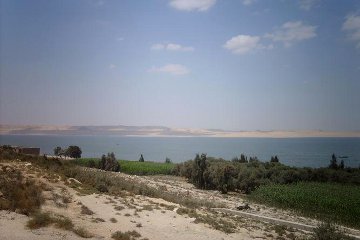
| |
| Lake Qarun, Egypt's inland sea, below sea-level in the Fayyum Oasis. |
Our final day of sightseeing was a day trip to the Faiyum, an oasis 60 miles south-west of Cairo that was the capital of Egypt in the 12th dynasty. The oasis supports a population of several million people today, the whole area watered by Joseph's Canal that enters in the south and flows into Lake Qarun in the north. In ancient times the lake was freshwater, but now, at 45 metres below sea level, it is as salty as seawater. Our visit included a brief look at some of the famous undershot water wheels for which the region is famous, as well two more pyramids: those of Amenemhet III at Hawwara, the site of the famous Labyrinth, and of Sesostris II at Lahun. Nearby is the workmen's town of Kahun where Israelite slaves probably lived while building the nearby pyramids.
Our tour groups include all age groups - this year the youngest was Nicholas, a Year 11 student from Canberra, and the oldest was 84-year old Merle, who, with the assistance of her daughter who accompanied her, visited every site and amazed everyone with her stamina and determination. Because the tour was scheduled during the school holidays, a number of secondary school teachers were part of the group, and even two ladies who were tour guides themselves!





